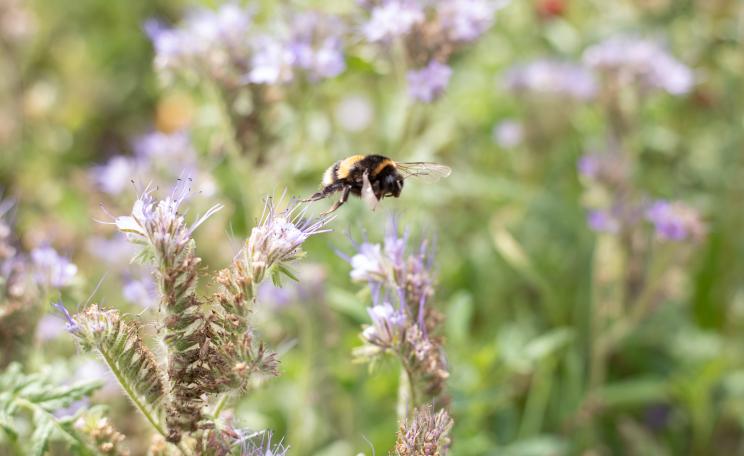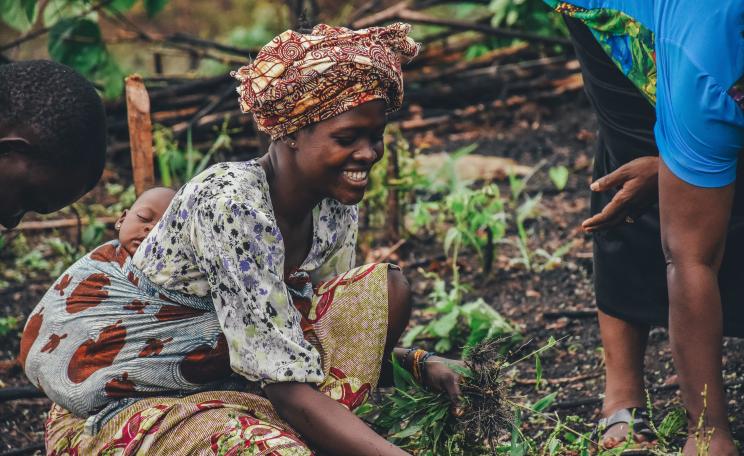This highly mechanised industry offers nothing in return, few jobs, and no benefit to local communities.
The beautiful fertile volcanic land known as ‘Tuscia’ is situated within central Italy’s provinces of Northern Lazio and Western Umbria around the lake of Bolsena.
An extremely long and rich agricultural tradition has existed since the ancient Etruscans settled here in around 700BC, attracted by the volcanic soil and Mediterranean climate.
Consequently, the crops are incredibly plentiful and diverse: vegetables and fruit, olive oil, grains and pulses, wines, cheeses, meats, freshwater fish, herbs and spices, essential oils and aromatic water.
Chemically
Agricultural produce from this area of Italy is considered some of the finest on the planet, the wines and olive oil are exported globally.
Unfortunately, in the last few years there have been dramatic changes.
Since 2018 almost 1,000 hectares of land around lake Bolsena has been appropriated by the chemically grown hazelnuts industry, the market for which is controlled by Italy’s largest private company.
Ferrero SpA uses 30 percent of the world’s hazelnut supply mainly for the production of its flagship brand ‘Nutella’, and in a plan known as ‘Progetto Nocciola Italia’, it has decided to shift its main production source out of Turkey, and orchestrate the planting of 20,000 hectares of hazelnuts in Italy by 2026.
The underlying reason for this move is that after many years of chemically driven intensive monoculture many of the Turkish plantations are becoming sterile and barren.
Humus
This highly mechanised industry offers nothing in return: few jobs, and no benefit to local communities.
The hazelnut is a ‘poor’ fruit which brings no benefits to an area - unlike the olive oil or wine industries - and its nutritional importance is negligible.
Profits are enjoyed by the growers, who depend largely on Ferrero to regulate the quality of their produce and the market price for hazelnuts.
The guarantee of this lucrative market has encouraged hazelnut speculators to offer high prices for land which local landowners have found hard to resist. Once sold, the land undergoes a complete ‘asset strip’.
It is bulldozed down to 50 centimetres deep, the topsoil is effaced with all its goodness, and the humus is ‘cleansed’, raked smooth, and then plugged with hazelnut shrubs, spaced symmetrically in rows, automated, faceless.
Pests
These new plants take five years to fruit, during which time they qualify for an ‘organic’ subsidy from the EU. The year fruiting starts, the spraying starts.
The hazelnut tree (Corylus avellana L.) is actually a shrub. It has deep roots and is traditionally found on slopes and mountainsides where the roots can bind and stabilise steep terrain, helping to prevent land slippage.
It flourishes best when grown within woods and forests where it is protected as part of a wider community of plant species, because every plant species carries within it a diverse apothecary of immunisation to ward off pests and disease.
This highly mechanised industry offers nothing in return, few jobs, and no benefit to local communities.
In this situation it needs no upkeep, chemical spray or excessive irrigation. The fruit is therefore pure, and abundant.
However, when confronted with the massive production quantity requirements of companies such as Ferrero, the hazelnut has to be farmed monoculturally, and becomes vulnerable to pests because there are no other plant species to protect it.
Pesticide
Growers resort to an artificial protection cocktail of pesticide treatments on the body of the plant, as well as herbicide on the ground underneath to protect the fruit once it falls.
The herbicides completely destroy the topsoil, no insects, small mammals or birds can live or feed there – consequently the biodiversity around hazelnut plantations is severely damaged.
Currently, there are no recommended organic treatments for hazelnuts used within the plantations from which Ferrero source their hazelnuts and crucially achieving organic hazelnut production is not one of Ferrero’s goals.
A closer study of the chemicals used reveals an alarming picture. Take for instance, the protection needed against the brown marmorated stink bug (Halyomorpha halys).
Reading the warnings advice from some of the recommended commercial pesticide treatments is frightening, especially for crops growing next to lakes.
Cancers
Lago di Vico is a small lake 50 kilometres south of Lago di Bolsena. Here, hazelnut plantations are much more established and the monocultural effect is openly visible.
Since as far back as 2008 it has been known that the water quality around Lago di Vico has been contaminated and unsuitable for human consumption.
In the last six months a joint research project undertaken by the Higher Institute of Health, the European Space Agency and the Academy Kronos in Ronciglione have proved conclusively through satellite spectrometric examination that the water of Lago di Vico contains an excessive load of chemical contaminants derived from hazelnut crops.
In particular it found high levels of a red algae cyanobacterium called Plankthotrix rubescens. This produces a microcystin which is harmful to human health, flora and fauna, and clearly classified by the International Agency for Research on cancer as highly carcinogenic.
This would also help to explain the high level of unusual cancers that have proliferated in recent years specifically around the areas of intensive hazelnut farming which was first brought to attention by Dotteressa Antonella Litta at her landmark conference on the subject in Vignanello April 2017.
Monoculture
The situation at lago di Vico contravenes European law and the Italian state is now facing a lawsuit.
The Lago di Bolsena is a much larger expanse of water. Covering over 100 square km, it is the largest volcanic crater lake in Europe, a beautiful tourist destination of great natural beauty, steeped in ancient history, it was where the Etruscans crowned their kings.
It has already suffered badly from sewage and agricultural pollution in recent years and current research has declared the ecological state of the lake to be alarmingly at the tipping point of ‘eutrophication’, a process that causes the degradation of an aquatic ecosystem caused by an over-abundance of nutrients in the water.
There are many hundreds of new hazelnut plantations within the hydrogeological basin of the lake that are already spewing poison into the underground aquifers.
Having no input river system, these aquifers are the only source of refill for the lake. The monoculturally farmed hazelnut also requires vast amounts of water, up to 30 litres per day, per plant, throughout the growing season.
Farmholdings
This level of irrigation is unsustainable in Tuscia, already affected by erratic weather patterns due to climate change. There is an environmental disaster waiting to happen.
The hazelnut industry is not just destroying the very environment it wishes to exploit, that is bad enough; but in Tuscia there is a young, vibrant, burgeoning agricultural community whose livelihoods will be severely compromised from this monocultural industry.
In recent years a younger generation of Italians has percolated to the countryside in search of an alternative way of life from the city.
It’s not difficult to understand their choice - the proximity to nature, clean air and good wholesome food, space for their children to play.
As a result of this migration a large amount of small organic farmholdings have sprung up in Tuscia cultivating exceptional fresh sustainable produce.
Threat
This group of pioneers share equipment and knowledge, they are bound by mutual cooperation and respect for the land, rather than exploitation and greed, and they have a strong work ethic.
Their produce is sold at their own farmer’s markets three times every month, where they also host talks on issues regarding the local area and educate the younger generation in artisanal skills like woodworking and basket weaving.
This is a renaissance of the spirit which has been lacking for so long within the agricultural community, exactly the opportunity needed to restore self respect for farming and extract it from many years of economic decline and EU policy which has heavily rewarded mega intensive farming with disproportional subsidies.
Make no mistake, farming organically and sustainably is not easy, and the uncertain seasons caused by climate change compound difficult predictions for future crops.
The creation of nutritious food and access to clean water is unquestionably one of the fundamental principles of life, and this principle is now under threat in Tuscia.
Growth
Farmers are highly stressed fighting for their rights to access ‘pesticide free’ water, air and soil, and they know that without action this time bomb will explode once spraying starts in 2023. This is injustice, this is a crime against peace, this is ecocide.
Our situation in Tuscia is a textbook example of ecocide, it is happening all over the world; here in the heart of central Italy it seems all the more shocking since we face the devastation of some of the highest quality agricultural land on the planet.
We are fighting against a system controlled by large corporations, a system where politicians are lobbied to retain the use of poisonous agricultural chemicals, where big supermarket chains are selling food so cheaply that small farmers cannot compete to make a living, and more disgracefully, 30 percent of all food produced is being wasted.
All the while, nature is screaming out for help, our biodiversity is being devastated, our populations are malnourished, our seasons are unpredictable. This must change. We will fight for nature’s right not to be exploited as an instrument of economic growth.
This Author
James P Graham is an artist and an eco-activist.





